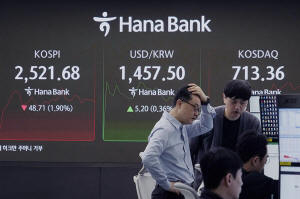World shares are mixed following Wall Street's panicked sell-off over
Trump's tariffs
[March 11, 2025] By
YURI KAGEYAMA
TOKYO (AP) — European and Asian benchmarks were mixed on Tuesday,
tracking a sell-off on Wall Street spurred by worries over the ripple
effects from President Donald Trump’s tariffs.
The futures for the S&P 500 and the Dow Jones Industrial Average were up
0.3%.
Germany's DAX gained 0.6% to 22,764,82, while the CAC 40 in Paris added
0.7% to 8,102.82. Britain's FTSE 100 lost less than 0.1% to 8,597.00.
Asian benchmarks skidded as worries grew over how sharply higher tariffs
will hurt exporters in the region.
Japan's benchmark Nikkei 225 sank 0.6% to 36,793.11, its lowest close in
six months but up from a more than 2% loss earlier in the day.
China's Shanghai Composite index picked up 0.4% to 3,379.83 as the
country's annual national congress wrapped up its annual session with
some measures to help boost the slowing economy.
In Hong Kong, the Hang Seng was nearly unchanged at 23,782.14.
Australia's S&P/ASX 200 lost 0.9% to 7,890.10. South Korea's Kospi
declined 1.2% to 2,537.60.
“Heightened anxiety surrounds both existing and incoming U.S. tariffs,
along with retaliatory measures from trading partners, and China’s newly
effective tariffs will continue to weigh on equities,” said Anderson
Alves, a trader at ActivTrades.

Also Tuesday, Japan slightly lowered its October-December economic
growth rate to an annual rate of 2.2%, revised from the 2.8% growth
given last month, citing lower consumer spending and higher private
inventories.
The stock fall in Asia echoed a sell-off Monday on Wall Street, where
investors are raising questions on how much painthe economy must endure
through tariffs and other policies in order to get what Trump wants.
The S&P 500 dropped 2.7%, closing 9% below its all-time high, which was
set just last month. At one point, the S&P 500 was down 3.6% and on
track for its worst day since 2022. That’s when the highest inflation in
generations was shredding budgets and raising worries about a possible
recession that ultimately never came.
The Dow dropped 2.1%, while the Nasdaq composite skidded 4%.
It was the worst day yet in a scary stretch where the S&P 500 has swung
more than 1%, up or down, seven times in eight days because of Trump’s
on -and- off -again tariffs. The worry is that the whipsaw moves will
either hurt the economy directly or create enough uncertainty to drive
U.S. companies and consumers into an economy-freezing paralysis.
[to top of second column] |

Currency traders watch monitors near a screen showing the Korea
Composite Stock Price Index (KOSPI), left, and the foreign exchange
rate between U.S. dollar and South Korean won, center, at the
foreign exchange dealing room of the KEB Hana Bank headquarters in
Seoul, South Korea, Tuesday, March 11, 2025. (AP Photo/Ahn Young-joon)
 The economy has already shown some
signs of weakening, mostly through surveys showing increased
pessimism. And a widely followed collection of real-time indicators
compiled by the Federal Reserve Bank of Atlanta suggests the U.S.
economy may already be shrinking.
Asked over the weekend whether he was expecting a recession in 2025,
Trump told Fox News Channel: “I hate to predict things like that.
There is a period of transition because what we’re doing is very
big. We’re bringing wealth back to America. That’s a big thing.” He
then added, “It takes a little time. It takes a little time.”
Trump says he wants to bring manufacturing jobs back to the United
States, among other reasons he’s given for tariffs. His Treasury
secretary, Scott Bessent, has also said the economy may go through a
“detox” period as it weans off an addiction to spending by the
government. The White House is trying to limit federal spending,
while also cutting the federal workforce and increasing
deportations, which could hinder the job market.
The U.S. job market is still showing stable hiring at the moment, to
be sure, and the economy ended last year running at a solid rate.
But economists are marking down their forecasts for how the economy
will perform this year.
The worries hitting Wall Street have so far been hurting some of its
biggest stars the most. Big Tech stocks and companies that rode the
artificial-intelligence frenzy in recent years have slumped sharply.
Nvidia fell another 5.1% Monday to bring its loss for the year so
far to more than 20%. It’s a steep drop-off from its nearly 820%
surge over 2023 and 2024.
Elon Musk’s Tesla fell 15.4% to deepen its loss for 2025 to 45%.
After getting an initial post-election bump on hopes that Musk’s
close relationship with Trump would help the electric-vehicle
company, the stock has slumped on worries that its brand has become
intertwined with Musk. Protests against the U.S. government’s
efforts to cull its workforce and other moves have targeted Tesla
dealerships, for example.
In energy trading, benchmark U.S. crude oil rose 24 cents to $66.27
a barrel. Brent crude, the international standard, rose 32 cents to
$69.60 a barrel.
In currency trading, the U.S. dollar rose to 147.29 Japanese yen
from 147.14 yen. The euro cost $1.0916, up from $1.0834.
All contents © copyright 2025 Associated Press. All rights reserved |